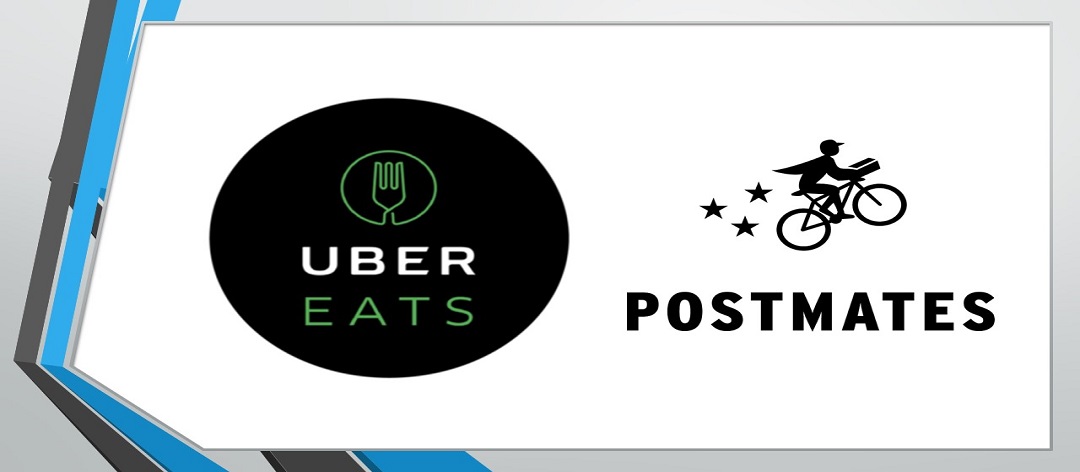Imagine not having to step out of your homes to collect anything from luxury electronic devices to home essentials like groceries. It sounds like paradise, doesn’t it? Thus, it should come as no surprise that online delivery services are ruling the markets. From tech-savvy individuals to people figuring out technology – everyone likes the convenience that it offers.
Among all the sectors, the competition in the food delivery services has been heating up in the past few years. Given this high demand, several players are entering the industry and trying to make a name for themselves. Among these, service providers like Uber Eats and Postmates have managed to establish themselves as leaders in the meal delivery sector.
From San Francisco to Chicago food delivery has never been easier, thanks to Uber Eats and Postmates. So, which of these on-demand delivery services is worth their salt? Let’s compare!
Uber Eats
Uber Eats is a food delivery website and application that is a subsidiary of Uber, a popular ridesharing service. It was founded in 2014 and partners with local restaurants to deliver freshly prepared meals right at your doorsteps.
What works in favour of Uber Eats is its clean design interface that is pretty much the same as that of booking a ride on Uber. As a result, it is something that users are familiar with and comfortable using.
Here’s a quick overview of how it works:
- Sign up for an Uber Eats account.
- Browse through the list of restaurants that deliver through Uber Eats.
- Go through the menu, check out the pricing, deals, etc. and build your cart.
- Place the order.
Postmates
Postmates was started in 2011 and, much like Uber, it is headquartered in San Francisco, California. Essentially, it operates in a manner similar to Uber Eats. You sign up for the service, browse through the restaurants, and place your order.
However, Postmates offers greater variety and options as restaurants do not have to partner with the service provider. Users can select any restaurant of their liking and add items to their cart to get them delivered.
Furthermore, Postmates is not limited to food delivery but also extends its services to groceries and alcohol too!
Uber Eats vs. Postmates: The Showdown
At the surface, it may appear that both the services have nearly a similar process of operation. However, it has become apparent by now that Uber Eats is about food delivery while Postmates have diversified their delivery services.
What are the other ways in which do the two service providers differ from each other? Let’s break it down:
1. Delivery Process
When a customer places their order on Uber Eats, the concerned restaurant directly receives it. The establishment then proceeds to start preparing it. Partner drivers will accept the delivery request and make their way to the restaurant.
Once the food is ready, the driver collects it and travels towards the customer. This journey can be tracked on the Uber Eats app. The driver then delivers it to the customer, either on the curb or at the doorstep.
On the other hand, when a customer places an order on Postmates, it notifies all the partners. After a driver accepts the order, the customer is notified of the estimated time for delivery. The driver then reaches the restaurant and places the order. Alternatively, in some cases, the restaurant gets an alert from Postmates.
From the above, it becomes clear that drivers have to put in a tad bit more of legwork on Postmates.
2. What’s in it for Restaurants?
To begin with, restaurants get access to a larger userbase. However, it comes at a cost. Restaurants have to pay a percentage share of their revenue as delivery processing fees.
For instance, Uber Eats charges around 20 to 25% commission, which can also go as high as 30%! On the other hand, the rates for Postmates may vary from 15 to 30%. Either way, these are much more than profit margins that a restaurant would make, so they have to resort to another method – jacking up the prices!
Several restaurants markup their menu prices to offset these charges. So a restaurant that sells something for $100 will have to sell it for $129.70 on Uber Eats and $140.50 on Postmates to accommodate the extra cost. Furthermore, Postmates may levy an additional service fee of 3% depending on the demand and a $1 fee as Merchant Fees.
The market share of Uber Eats and Postmate vary from city to city. For example, in Los Angeles, Uber Eats occupies 15% of the market share while Postmates occupies 37%.
In contrast, Uber Eats has a 55% market share in Miami and 40% in Atlanta, while Postmate registers 18% and 8%, respectively. Interestingly, Postmates also has the lowest percentage of exclusive customers at 41%, while Uber Eats has 53% of customers using it exclusively.
From the above comparison, it becomes abundantly clear that Uber Eats enjoys a better equation with its partner restaurant as opposed to Postmates. This deduction may be based on the restaurant commission rate, customer base, and market share.
However, not all restaurants operate similarly and determining this is a result of several factors that may be typical to a business.
Final Thoughts
The role of third-party food delivery apps in increasing the bottom line of a restaurant is highly debatable. One may argue that restaurants are gaining long-term profits by increasing their clientele.
However, this logic is highly subjective as it is a product of several considerations ranging from demand and location to commission. Furthermore, the practise of marking up the price of items on the menu has come under fire often and gained general flak from users who are unaware of the pricing model.
Regardless, customers are lapping up the ease and convenience that these apps offer. They do not have to interact with the restaurant and can have their item delivered directly to their homes or workplaces. Additionally, the discounts and promos offered by the service providers is yet another pull towards such services.







